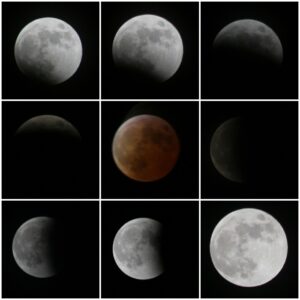 The December sky is remarkable this year, with the Geminid meteors on the 13th and the lunar eclipse on the 21st.
The December sky is remarkable this year, with the Geminid meteors on the 13th and the lunar eclipse on the 21st.
Venus can be seen as the “morning star” in the eastern sky in the hours before sunrise, and is especially bright the first week of December. The Summer Triangle, which we saw straight overhead earlier, is shifting to the northwest. It is not as easy to see the Big Dipper as it was in the fall, due to our light pollution near our northern horizon.
Meteor Showers 12/13
The night of December 13-14 has one of the best shows of the year. These meteors are visible in the constellation Gemini, in the southern sky, all night.
Lunar Eclipse 12/21
The shadow of the earth will slowly cover the moon, as seen from most of North America, on December 21st. At about 12:28 AM, Eastern Standard Time, the earth’s shadow will start to block the light from the sun on the moon. The moon may appear copper or reddish during an eclipse. It will end at about 6 AM. Let’s hope for a clear night. The constellations that will be more visible due to the eclipse, in the sky near the moon, are Orion, Gemini and Taurus. It is the night of the full moon, so stars would be less visible normally, due to the moonlight.
Go to http://www.jpl.nasa.gov/video/index.cfm?id=950 for the latest NASA video covering the lunar eclipse.
The first graders, one second grade and one fifth grade class will get to meet Dr Randii Wessen, a NASA jet propulsion lab scientist, on Dec. 17. He is from Queens originally, and is taking time out from a family visit to come to The Children’s School. He is an expert on robotics in space. Some of the children may be reporting that an astronaut is coming; Dr. Wessen is merely a rocket scientist! We hope he likes us so much that he will want to come back. Please visit solarsystem.nasa.gov for the NASA education website, which has many educational videos, resources and games.
